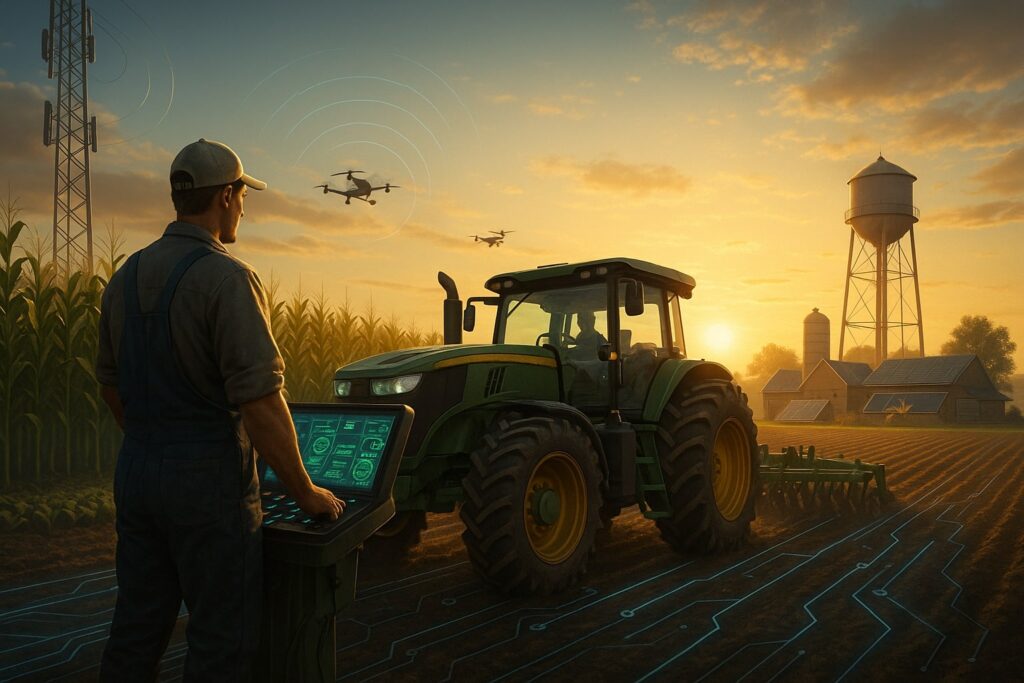The U.S. Department of Agriculture’s recent $152 million investment in rural Iowa is more than a one-off funding announcement – it signals a strategic shift toward tech-enabled farming in America’s heartland. Unveiled at the Iowa State Fair, the package spans 19 projects across 20 counties, ranging from a $37 million hospital expansion to 13 water and wastewater upgrades, plus grants for road improvements and rural business growth. Beneath the surface of these infrastructure projects lies a clear economic message: modernizing rural foundations is seen as a prerequisite to unleashing precision agriculture and attracting private capital. In underserved counties that have long struggled to keep pace, the USDA’s coordinated push suggests rural prosperity is being treated not just as a local issue but as a national strategic priority. Investors and AgTech innovators are taking note that places once overlooked may soon become fertile ground for new technologies and business growth.
Table of Contents
ToggleInfrastructure as a Catalyst for AgTech Adoption
By design, much of the funding shores up basic infrastructure – hospitals, water systems, electricity, and broadband – which in turn creates conditions for advanced agricultural technology to take root. Take the case of water and power improvements: one project will build two new wells, a treatment plant and transmission lines for Southern Sioux County’s water system, while an $8.5 million rural electric loan will upgrade 84 miles of lines and connect 180 new consumers. These upgrades aren’t just about reliability; they directly enable high-tech farming practices. Reliable water and electricity allow farmers to deploy sensor-driven irrigation and electrified precision equipment without fear of outages. Indeed, precision agriculture experts have long argued that modernizing rural utilities – especially broadband internet – is essential for next-generation farming. A recent federal study noted that many U.S. farms can only adopt data-heavy tools if robust internet connectivity is in place, and by financing rural fiber and grid upgrades (the Iowa package includes substantial telecom loans and electric coop investments), USDA is effectively lowering the barrier to entry for digital agriculture across these communities.
There is a historical parallel here. Just as rural electrification in the 20th century unlocked mechanization on farms, today’s “e-connectivity” is poised to unlock precision ag. The Economic Research Service has documented how past USDA rural development programs put billions into digital infrastructure projects, recognizing that extensive adoption of precision agriculture depends on modern telecommunications in rural areas. Now, with dedicated funding flowing into Iowa’s local utilities and broadband, that principle is being put into practice on the ground. We can reasonably expect farmers in these counties to ramp up use of GPS-guided equipment, drone imagery, soil IoT sensors, and data analytics – technologies that are already proven to improve yields and input efficiency. In fact, Iowa farmers have shown strong interest in precision tools: even a few years ago, over half were using GPS yield monitors, though fewer (just 12%) had adopted on-farm sensor networks. The gap often boils down to cost and connectivity. With new infrastructure lowering both those hurdles (for instance, broadband makes cloud-based decision tools feasible, and power upgrades allow charging of electric machinery), the stage is set for a broader AgTech rollout in Iowa’s rural communities.

Economic Signals and Regional Disparities
USDA Secretary Brooke Rollins framed the Iowa initiative as a matter of national security and economic resilience, underscoring that “rural prosperity is truly a national security issue”. The economic signal here is that robust rural economies are as important to the nation as urban tech hubs. By investing at “historic levels” in Iowa’s counties, the federal government is implicitly acknowledging the regional disparities that have left some farming communities infrastructure-poor and tech-deprived. Many of the funded projects target counties that have seen population outflows and underinvestment. For example, the city of Emmetsburg will get $44 million in loans and grants to replace a 1970s-era wastewater plant – exactly the kind of costly project that a small community could never tackle alone. Meanwhile, places like Linn Grove and Ute are receiving micro-grants for basic water assessments and connections. Such improvements, while not flashy, aim to level the playing field for underserved locales. They address the “preconditions” for economic activity – clean water, health services, passable roads – that have lagged behind in these areas.
By reducing these infrastructure gaps, the USDA funding can help narrow regional disparities in agricultural productivity. Counties with reliable utilities and healthcare will be better positioned to retain skilled workers and attract agribusiness investment. There is also an implicit acknowledgment of the digital divide: some Iowa counties, particularly rural ones, have lagged in broadband access despite FCC claims of near-complete coverage. The plan’s hefty telecom loans (a reported $110 million dedicated to broadband expansion in the state) suggest policymakers want to eradicate remaining dead zones. That would be a game-changer for precision ag adoption. Researchers note that many rural areas lack the broadband needed for data-intensive farming, and government support is needed to expand access. With Iowa set to receive an additional $415 million in federal broadband funds through the BEAD program, the state’s rural connectivity is on track to improve dramatically. This convergence of infrastructure investment directly addresses disparities between well-connected farming regions and those left offline. In economic terms, it could enable more uniform productivity gains statewide, rather than only in pockets where connectivity and capital were already present.
Another economic signal comes from the types of projects funded. Several initiatives explicitly support value-added agriculture and local processing – for instance, a pass-through loan to expand a soy processing plant in Butler County and Resilient Food Systems grants to strengthen local supply chains. This suggests a strategic tilt toward diversification and resilience. Rather than just propping up commodity production, the USDA wants rural Iowa to climb the value chain (e.g. processing soy locally rather than shipping out raw beans) and to develop more localized food systems that can buffer global shocks. For underserved counties, this could mean new jobs in food processing, storage and distribution – a departure from the traditional pattern where raw outputs left the county and little downstream income stayed behind. The focus on agribusiness modernization also indicates that rural Iowa is expected to contribute to climate-smart agriculture – upgrades like electric co-op improvements position farms to adopt solar panels and efficient irrigation. The economic message is clear: modern infrastructure will help these communities participate in emerging green and tech-driven markets, rather than be left behind.
Technology Suppliers and Investors Poised to Benefit
If rural Iowa’s groundwork is being reinforced, who stands ready to capitalize on the coming AgTech wave? On the one hand, farmers and local businesses stand to gain from cost savings and new opportunities. But on the other hand, suppliers of agricultural technology and services see a newly expanded market. Major ag equipment manufacturers – think of GPS-guided tractor makers or drone and sensor companies – will find a more receptive customer base as Iowa’s rural internet and electric capacity improve. For example, a farmer might have held off on purchasing advanced telemetry for irrigation if network coverage was spotty; once broadband towers go up, that hesitation fades. Companies like John Deere (a leader in precision farming tech) and various ag-tech startups could see upticks in demand. Notably, farmers are already optimistic about tech benefits: in surveys, over 75% of Iowa farmers agreed precision tech boosts efficiency and yields. As infrastructure catches up to that appetite, suppliers of everything from satellite imagery services to AI-driven crop monitoring tools could see growth.
Investors are certainly watching this space. The USDA’s investment explicitly encourages private investment to follow. The idea is that public funds “de-risk” rural projects enough to attract venture capital and banks. Early evidence of this effect is emerging. Observers have pointed out strategic opportunities such as “infrastructure-linked real estate” – investing in property in towns like Emmetsburg set to benefit from new utilities – and AgTech startups leveraging USDA grants for local pilots. Tech entrepreneurs who might have focused on urban markets are now eyeing rural Iowa for pilot projects in telemedicine, ag-fintech, or farm robotics, knowing that the necessary scaffolding (internet, roads, reliable power) will be in place. We are essentially seeing the creation of new markets in areas that were previously considered too underdeveloped to bother with.
Importantly, the suppliers poised to benefit aren’t only the big multinationals. Local and regional firms could gain a foothold. For instance, Iowa’s own startups in precision livestock farming or soil health analytics may find it easier to sign up beta testers among the newly connected farms. Additionally, community banks and credit institutions could see business growth as entrepreneurs set up shop in revitalized small towns. It’s telling that the funding includes support for cooperative development and revolving loan funds in rural counties – essentially seeding local financial infrastructure to fund new ventures. This will help channel capital to smaller tech suppliers and service providers on the ground. In broader terms, the infusion of funds validates rural markets as worthwhile for investment. Financial analysts note that rural infrastructure spending tends to precede broader economic upticks. We can therefore anticipate a multiplier effect: construction jobs and procurement in the short term, followed by longer-term gains as improved infrastructure raises property values and business productivity.
From Underserved to Innovation Hubs?
One of the more thought-provoking aspects of USDA’s Iowa push is how it reframes “underserved” counties as potential innovation hubs. For years, rural America has been viewed by investors as a stagnant if not declining market. Now, the narrative is shifting. By explicitly linking infrastructure to precision ag rollouts, officials are painting a picture of rural counties as the next frontier for tech adoption. There is an alignment of interest here: policymakers want to shore up food supply chains and rural employment, while tech companies need new customers and testbeds for innovations. Underserved Iowa communities could become living labs for agricultural AI, broadband telehealth, and clean energy on farms, showcasing models that can be replicated elsewhere. Notably, the USDA is aligning its rural strategy with climate goals, supporting projects like solar array integration via electric co-ops and climate-resilient farming practices. This means tech related to renewable energy, carbon sequestration, and climate adaptation will find friendly ground in these counties.
There are still challenges, of course. Bridging the digital divide is not just about laying fiber optic cable; it also requires digital literacy and affordable service for farmers. Some skeptics point out that even with infrastructure, adoption can lag if farmers are concerned about costs or data privacy. Yet the current economics of farming may compel adoption of efficiency-boosting tech. With tight margins, any tech that can reduce input costs or improve yields is attractive – and many precision tools do exactly that. In fact, 87% of farmers agree that precision tech can increase efficiency of input use, which directly affects the bottom line through savings on seed, fertilizer, and fuel. As more success stories emerge from early adopters in Iowa (for example, a farmer using sensors and aerial imagery to boost yields on less land), peer effects will spur broader uptake. The USDA investments accelerate that timeline by removing some external barriers (like poor internet or inadequate credit access).
For the broader investor and entrepreneur community, rural Iowa’s transformation holds a lesson: significant opportunities exist in places often written off as too small or risky. The combination of public investment and receptive local communities can create markets that didn’t previously exist. We are likely to see a “crowding-in” of private capital following the public dollars. In addition, this could mitigate regional inequality by creating tech-driven prosperity beyond the coasts and big cities. If the experiment succeeds, we might witness Iowa’s underserved counties evolving into thriving nodes of AgTech innovation – a development that could reshape the rural economy and help secure the nation’s food and energy future. No longer sidelined, rural markets are now thriving ecosystems—brimming with potential and ready for strategic capital. With the groundwork now being laid in Iowa, the coming years will test just how quickly those ecosystems can grow when given the tools to flourish.




